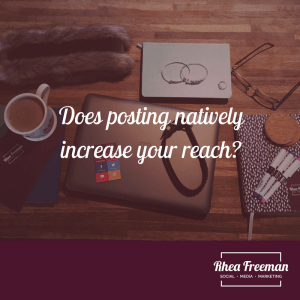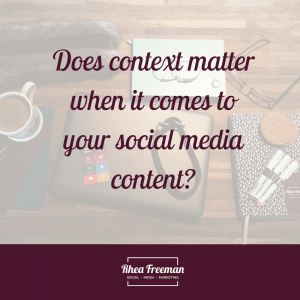 Does posting natively increase your reach? Well, there are a few things to consider here – and a few points were raised in a previous blog about context and content… but let’s dive in.
Does posting natively increase your reach? Well, there are a few things to consider here – and a few points were raised in a previous blog about context and content… but let’s dive in.
What do you mean by ‘posting natively’?
Posting direct to the platform and not making people move around to view content. This works with blogs, vlogs and links to websites. And I get the irony that this is a blog and has been promoted on my social media platforms. But you’ll notice how that even though the blog isn’t native to the platforms I’m promoting it on, I’m creating native content to promote the blog… did you see a graphic on Facebook or did you just see a boring old link with no imagery? I hope you saw the graphic that I uploaded to Facebook so I could combine the benefits of the native posting with the benefits of bringing you here to my little corner of the internet.
Does posting natively increase reach?
Yep. And this is two fold. Thinking of Facebook, it’s said (and in my experience this is correct!), that the algorithm prefers native content. And why wouldn’t it? Watching stuff natively on the platform and not venturing off to other sites is a win for any website. Even when you’re as big as Facebook. For the consumer too, you click it, you watch it, you get bored, you move on. You don’t have to open and close tabs to get back to where you were. And the other reason that native posting can increase reach is simply because it looks a whole lot better in the feed. This means it looks a LOT more interesting and will encourage a lot more engagement.
Should I only post natively?
Yes and no. If you take the example of video, you might be looking to develop your Youtube channel, but want to use your Facebook page to help promote your videos. So what do you do? There are a few options. You can just post a link to your video on Facebook and hope for the best, fully aware that it doesn’t look half as good as a native post and that the reach will be less – but it will link to Youtube and you’ll get your views there. You could post an image from the video natively and also post the link to the video. It looks visually more inviting and you still drive people in the right direction. You create a short ‘trailer’ and post that video natively and include the link to Youtube. You post natively to Facebook. By which I mean you post the WHOLE video natively to Facebook and, if you like, to Youtube. If your objective is views, wherever they come from, this can work well.
Here’s just one example of how posting natively can increase your reach – what do you think? How did you do it? I’d love to hear…

 Does context matter when it comes to your social media content? It’s something that I am constantly aware of, but a post I saw on Instagram last week prompted me to blog.
Does context matter when it comes to your social media content? It’s something that I am constantly aware of, but a post I saw on Instagram last week prompted me to blog.